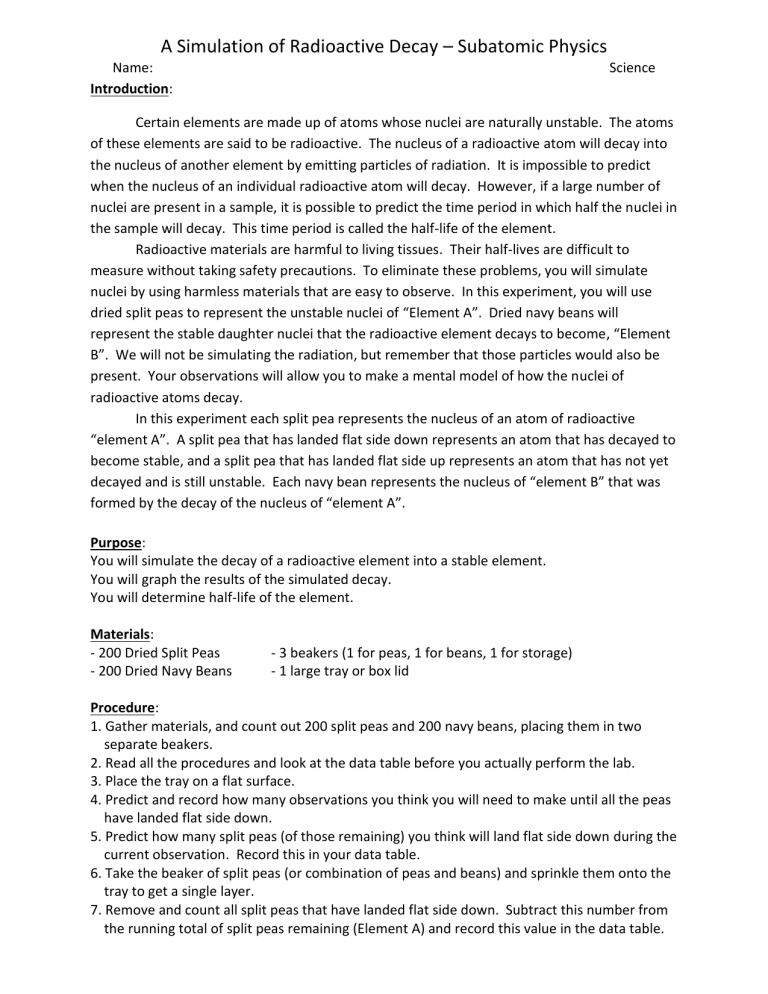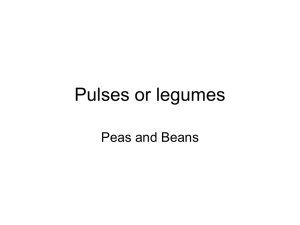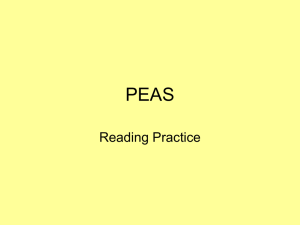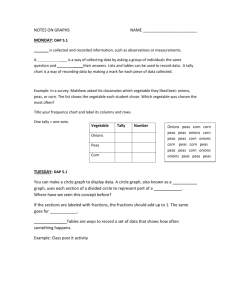Half-life lab

Name:
A Simulation of Radioactive Decay – Subatomic Physics
Science
Introduction:
Certain elements are made up of atoms whose nuclei are naturally unstable. The atoms of these elements are said to be radioactive. The nucleus of a radioactive atom will decay into the nucleus of another element by emitting particles of radiation. It is impossible to predict when the nucleus of an individual radioactive atom will decay. However, if a large number of nuclei are present in a sample, it is possible to predict the time period in which half the nuclei in the sample will decay. This time period is called the half-life of the element.
Radioactive materials are harmful to living tissues. Their half-lives are difficult to measure without taking safety precautions. To eliminate these problems, you will simulate nuclei by using harmless materials that are easy to observe. In this experiment, you will use dried split peas to represent the unstable nuclei of “Element A”. Dried navy beans will represent the stable daughter nuclei that the radioactive element decays to become, “Element
B”. We will not be simulating the radiation, but remember that those particles would also be present. Your observations will allow you to make a mental model of how the nuclei of radioactive atoms decay.
In this experiment each split pea represents the nucleus of an atom of radioactive
“element A”. A split pea that has landed flat side down represents an atom that has decayed to become stable, and a split pea that has landed flat side up represents an atom that has not yet decayed and is still unstable. Each navy bean represents the nucleus of “element B” that was formed by the decay of the nucleus of “element A”.
Purpose:
You will simulate the decay of a radioactive element into a stable element.
You will graph the results of the simulated decay.
You will determine half-life of the element.
Materials:
- 200 Dried Split Peas
- 200 Dried Navy Beans
- 3 beakers (1 for peas, 1 for beans, 1 for storage)
- 1 large tray or box lid
Procedure:
1. Gather materials, and count out 200 split peas and 200 navy beans, placing them in two
separate beakers.
2. Read all the procedures and look at the data table before you actually perform the lab.
3. Place the tray on a flat surface.
4. Predict and record how many observations you think you will need to make until all the peas
have landed flat side down.
5. Predict how many split peas (of those remaining) you think will land flat side down during the
current observation. Record this in your data table.
6. Take the beaker of split peas (or combination of peas and beans) and sprinkle them onto the
tray to get a single layer.
7. Remove and count all split peas that have landed flat side down. Subtract this number from
the running total of split peas remaining (Element A) and record this value in the data table.
8. Replace all split peas removed with the same number of navy beans, and add this number to
the running total number of navy beans and record this total in the data table.
9. Place the removed peas in the third beaker for storage.
10. Place all remaining peas (flat side up) and the navy beans (just added to replace the peas
removed and ones previously there), in the “dumping beaker” which was originally just peas.
11. Repeat steps #5-11 until all split peas have landed flat side up.
Data Table:
How many observations do you think you will make until there are no split peas remaining? ______
Prediction of
Observation # Time (minutes) how many split peas will decay during this
Number of Nuclei
(Always totals 200)
# of Split Peas
Remaining
Total # of Navy
Beans observation. “Element A” “Element B”
0
1
2
3
4
5
6
7
8
9
10
11
12
13
14
0 minutes
5 minutes
10 minutes
15 minutes
20 minutes
25 minutes
30 minutes
35 minutes
40 minutes
45 minutes
50 minutes
55 minutes
60 minutes
65 minutes
70 minutes
XXXXXXXXXXXXX
XXXXXXXXXXXXX
200 0
Analysis:
Assuming that there is approximately 5 minutes between observations, the time column on the data table has been filled in to show this time measurement. Use the data in the table to graph the results of your experiment. One axis will be time, while the other axis will be number of nuclei remaining. Remember to put the independent variable on the horizontal axis, versus the dependent variable on the vertical axis.
Plot points and graph “element A” by connecting the points. Then on the same graph plot points and graph “element B” by connecting these points. Use different colors for showing the two separate curves. Label the graph and include a key to distinguish between “Element A” and “Element B”.
Questions and Conclusions:
1. Using your graph, determine the half-life of the radioactive element (split peas). How did
you come up with your answer?
2. Using the your graph, determine the number of atoms of the radioactive element remaining
after two of your calculated half-lives, and after three half-lives.
3. Why do you think you replaced the split peas, but never replaced any of the navy beans?
4. The data you plotted on the graph should look like mirror images. Explain why this is so.
5. Suppose you were given 400 dried split peas to do this experiment.
a. Could you accurately predict when (during which observation) an individual split pea will fall
flat side up? Why or why not?
b. Predict how many split peas should remain after three observations?
c. Can you 100% accurately predict how many split peas will remain after three observations?
Why or why not?








